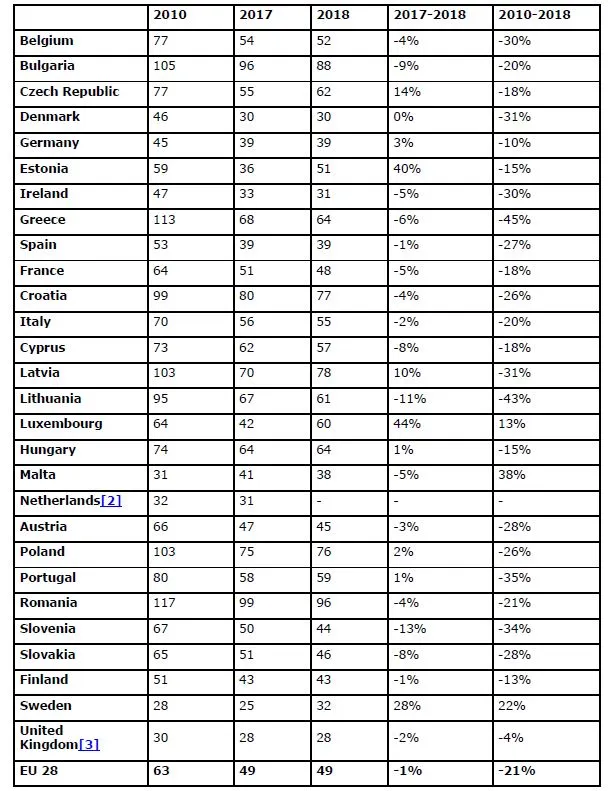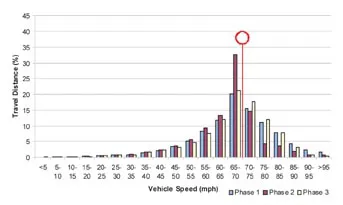Young powered two wheelers are most at risk of crashing. That is the key finding of a recent report into powered two wheeler crashes in Europe. The analysis of 9,186 crashes where a motorcyclist was severely injured, shows that specifically young, male riders face a significant risk to become a road traffic victim.
The European Commission recently published the ‘Study on serious road traffic injuries in the EU’ to collate data that could in the future prevent serious road traffic injuries. The aim was to
January 20, 2017
Read time: 4 mins
Young powered two wheelers are most at risk of crashing. That is the key finding of a recent report into powered two wheeler crashes in Europe. The analysis of 9,186 crashes where a motorcyclist was severely injured, shows that specifically young, male riders face a significant risk to become a road traffic victim.
The2465 European Commission recently published the ‘Study on serious road traffic injuries in the EU’ to collate data that could in the future prevent serious road traffic injuries. The aim was to deliver an analysis on the most common circumstances and types of road traffic crashes leading to serious injuries.
The study was also directed at providing an understanding of the main circumstances and factors that affect the emergence of serious road traffic injuries, medically coded as MAIS3+, for the following road traffic modes in the European Union: pedestrians, cyclsits, motorcyclists and car occupants.
In total the researchers analysed 9,186 crashes which a motorcyclist was severely injured. They used data from nine European countries: Austria, Czech Republic, France, Germany, Italy, the Netherlands, Sweden, Spain and the United Kingdom. From these databases, some key points become clear.
The majority of severely injured motorcyclists (91%-96%) are males and most (95%) are the rider. Dominant age groups are youngsters (18-24 years) and in Sweden, Germany, the Netherlands and the United Kingdom also, middle aged adults (around 40 years old). Of note is that in Germany, this group of middle aged adults is the most dominant.
In most countries, the majority of motorcycle crashes in which riders are severely injured also involve cars (42%-59%) and two active road users are involved in the crash (46%-67%). However single vehicle crashes and crashes into fixed objects are also very common. This is particularly true in Sweden, where single vehicle crashes are more common than crashes that also involve a car.
The impact location for severe motorcyclist crashes is most often to the front, with side-impacts as the second most frequent. Meanwhile a turning manoeuvre or going straight (sometimes in a bend) are common in severe motorcyclist crashes.
In some countries, rural road crashes outnumber those on urban roads: 45%-55% rural crashes are observed in the Netherlands and Sweden. Other countries have most severe motorcyclist crashes on urban roads: 53%-60% urban crashes are observed in Germany and the UK. The study concludes that severe motorcyclist crashes are not a major problem on motorways.
Summer and spring are the periods where high proportions of MAIS3+ motorcyclist crashes happen. As with all transport modes, crashes happen frequently in the afternoon, between 15.00 and 18.00.
For motorcyclists, the body regions most severely affected are most frequently the thorax and lower extremities. Also head injuries and injuries to the upper extremities are common. Thorax injuries are most frequently found in single vehicle crashes and crashes with a fixed object, while lower extremity injuries are particularly found in crashes with a car.
The report also showed evidence for other contributing crash factors. For severe motorcycle crashes, the following were found to be most common, with failure to look properly accounting for 40% or vision affected 34%; speeding or inappropriate speed for conditions account for 26-34%, while loss of control accounts for 25%. Meanwhile poor turn or manoeuvres account for 25-31%, failed to judge path or speed of other road user account for 23% and careless or reckless behaviour account for 23-43%.
Analysing the profile of crash characteristics and scenarios that describe fatal crashes, key findings are apparent as more than 90% of killed motorcyclists were male, although larger shares of female fatalities were found in Ireland and Sweden. Fatal motorcycle crashes are dominant in the age group of young adults and in some countries also in the group of older riders, especially in central European countries. The majority of fatal motorcyclist crashes occur on rural roads. Most fatal motorcycle crashes occur during spring and summer.
The study did not investigate effective measures to prevent serious injuries, but according to the researchers “the findings provide support that a number of measures that are known to be effective for the prevention of fatal crashes could also help in reducing at least some of the serious injuries.”
One key benefit would be the introduction of forgiving infrastructure for all vehicle modes, such as shielded or obstacle free road sides, motorcycle-friendly guard rails and poles. Another would be better infrastructure for two-wheeled vehicles, including powered two wheelers. This shows that both bicycles and motorcycles can benefit from sufficiently wide special lanes, well maintained pavements and prevention of road surface defects such as potholes and differences in height between the pavement and the road side.
The study does however recognise that “for some Member States these measures might already be implemented on a large scale, for other Member States implementation might be a real challenge.”
The
The study was also directed at providing an understanding of the main circumstances and factors that affect the emergence of serious road traffic injuries, medically coded as MAIS3+, for the following road traffic modes in the European Union: pedestrians, cyclsits, motorcyclists and car occupants.
In total the researchers analysed 9,186 crashes which a motorcyclist was severely injured. They used data from nine European countries: Austria, Czech Republic, France, Germany, Italy, the Netherlands, Sweden, Spain and the United Kingdom. From these databases, some key points become clear.
The majority of severely injured motorcyclists (91%-96%) are males and most (95%) are the rider. Dominant age groups are youngsters (18-24 years) and in Sweden, Germany, the Netherlands and the United Kingdom also, middle aged adults (around 40 years old). Of note is that in Germany, this group of middle aged adults is the most dominant.
In most countries, the majority of motorcycle crashes in which riders are severely injured also involve cars (42%-59%) and two active road users are involved in the crash (46%-67%). However single vehicle crashes and crashes into fixed objects are also very common. This is particularly true in Sweden, where single vehicle crashes are more common than crashes that also involve a car.
The impact location for severe motorcyclist crashes is most often to the front, with side-impacts as the second most frequent. Meanwhile a turning manoeuvre or going straight (sometimes in a bend) are common in severe motorcyclist crashes.
In some countries, rural road crashes outnumber those on urban roads: 45%-55% rural crashes are observed in the Netherlands and Sweden. Other countries have most severe motorcyclist crashes on urban roads: 53%-60% urban crashes are observed in Germany and the UK. The study concludes that severe motorcyclist crashes are not a major problem on motorways.
Summer and spring are the periods where high proportions of MAIS3+ motorcyclist crashes happen. As with all transport modes, crashes happen frequently in the afternoon, between 15.00 and 18.00.
For motorcyclists, the body regions most severely affected are most frequently the thorax and lower extremities. Also head injuries and injuries to the upper extremities are common. Thorax injuries are most frequently found in single vehicle crashes and crashes with a fixed object, while lower extremity injuries are particularly found in crashes with a car.
The report also showed evidence for other contributing crash factors. For severe motorcycle crashes, the following were found to be most common, with failure to look properly accounting for 40% or vision affected 34%; speeding or inappropriate speed for conditions account for 26-34%, while loss of control accounts for 25%. Meanwhile poor turn or manoeuvres account for 25-31%, failed to judge path or speed of other road user account for 23% and careless or reckless behaviour account for 23-43%.
Analysing the profile of crash characteristics and scenarios that describe fatal crashes, key findings are apparent as more than 90% of killed motorcyclists were male, although larger shares of female fatalities were found in Ireland and Sweden. Fatal motorcycle crashes are dominant in the age group of young adults and in some countries also in the group of older riders, especially in central European countries. The majority of fatal motorcyclist crashes occur on rural roads. Most fatal motorcycle crashes occur during spring and summer.
The study did not investigate effective measures to prevent serious injuries, but according to the researchers “the findings provide support that a number of measures that are known to be effective for the prevention of fatal crashes could also help in reducing at least some of the serious injuries.”
One key benefit would be the introduction of forgiving infrastructure for all vehicle modes, such as shielded or obstacle free road sides, motorcycle-friendly guard rails and poles. Another would be better infrastructure for two-wheeled vehicles, including powered two wheelers. This shows that both bicycles and motorcycles can benefit from sufficiently wide special lanes, well maintained pavements and prevention of road surface defects such as potholes and differences in height between the pavement and the road side.
The study does however recognise that “for some Member States these measures might already be implemented on a large scale, for other Member States implementation might be a real challenge.”








